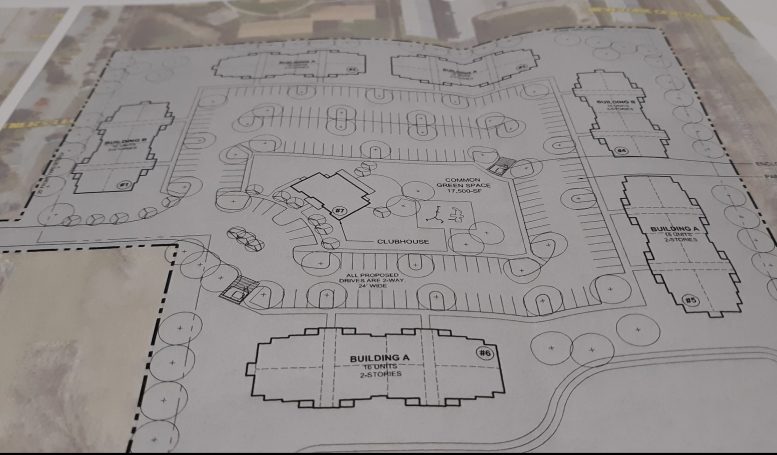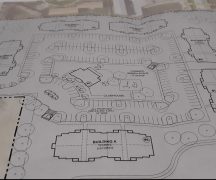By JAN LARSON McLAUGHLIN
BG Independent News
Parking spaces – or rather lack of parking – sank a variance request for a new apartment complex in Bowling Green.
Developers of a 96-unit apartment complex failed to get their requested variance Wednesday evening when a tie vote by the Bowling Green Zoning Board of Appeals was not enough to grant variance.
The development, by Wallick Communities, is proposed on property owned by Lloyd and Linda Fite, in the 900 block of South Main Street. The property, which is vacant, is bordered by the CSX tracks on the east, and by existing apartment complexes in the 200 and 300 blocks of Napoleon Road to the north.
The driveway for the complex would likely have been south of the Pagliai’s restaurant, according to City Planning Director Heather Sayler.
Proposed are 96 apartments – which several of the zoning board members agreed were needed in Bowling Green.
But the problem was the number of parking spaces for the complex – 202 – rather than the required 358 spaces for that size of a complex.
The developers requested a variance for the parking requirement and for the maximum lot coverage, since the complex would cover 50% of the property rather than the 40% maximum.
The property is already zoned R-3 for multiple-family residential – but the developers said the variance is needed in order to make the project affordable.
The one-, two- and three-bedroom apartments are intended for the target population of the local workforce residents, rather than college students, according to Jimmy McCune and Tyler Ponder, of Wallick Communities.
Data shows that Wood County is lacking affordable rental housing, McCune said. The developer is seeking tax credits from the state to help with the project. The units would not be Section 8 housing, but to qualify for state tax credits the apartments would be rented to people earning 80% of the area median income.
Ponder said the project will be at investment of up to $12 million.
“We don’t want that to get held up by parking,” he said.
McCune said two spaces per apartment is appropriate, since the developer also wanted to provide green space for children in the development. Adding more parking spots would also cut into the clubhouse and the required stormwater retention, he said.
The variance would allow for that “happy balance,” McCune said.
Zoning board member Judy Ennis voiced her reservations about the parking variance.
“I am concerned that your request for spaces is really limiting,” she said.
Zoning board member Hobart Johnson asked McCune to explain the hardship faced by the developer – since that is the criteria for approving variances to the zoning code.
McCune said adding more parking would mean fewer apartments, which would make the project less affordable.
Johnson said he believed it was “impractical” to have 202 parking spaces for 96 apartments since some of the three-bedroom apartments would likely have more than two vehicles, and since parking should be available for guests.
Zoning board member Rose Hess asked how the project would be targeted at non-college student renters.
Ponder said full-time students would not qualify to rent units.
“You can’t discriminate against students,” said zoning board member Chris Ostrowski, who added that six students with six vehicles could rent one three-bedroom apartment.
“In theory,” McCune said.
“In this town of students it happens in practice” not just theory, Ostrowski said.
McCune noted the need for multi-family housing in Bowling Green.
“There’s an enormous demand for this type of property,” he said. “We wouldn’t market them to students.”
“I think they’d find them,” Ostrowski countered.
Ponder said the complex will be “family housing” and having a lot of extra parking could make the spaces attractive to students just looking for a place to park their vehicles.
Ostrowski agreed there is a need for more multi-family housing in the city, but the number of proposed parking spaces is “just asking for trouble.”
“The parking issue is a serious one,” he said. “Pushing a project through without enough parking is a big mistake.”
Zoning board member Matt Bostdorff also acknowledged the need for more high density housing.
“I’m constantly hearing about the need for housing in town,” Bostdorff said, noting trends of more people relying on public transportation and working from home.
But Ostrowski pointed out, “we’re not real big on public transportation” in Bowling Green.
It was suggested that some of the potential problems with the parking could be prevented by assigning parking spaces.
Sayler advised the zoning board that part of the city’s zoning code update is looking at the reduction in required parking spaces with residential and commercial developments. The city currently has “very, very extreme parking requirements,” she explained.
Some planning commission members agreed that while the required 358 spaces may be too much, the proposed 202 are not enough.
McCune said the submission date for the annual state funding cycle is next week. But Ennis pointed out that the R-3 zoning is already in place, so that should not hold up the project. While the variance may make the project more affordable to the developer, McCune said it is not necessary for the state tax credit approval.
The vote on the variance was tied, with “yes” votes from Bob Waddle, Matt Bostdorff and Judy Ennis, and “no” votes from Hobart Johnson, Chris Ostrowski and Rose Hess.
Ennis advised the developers that “you have options” of bringing back a revised plan to the zoning board or appealing the matter in court.





